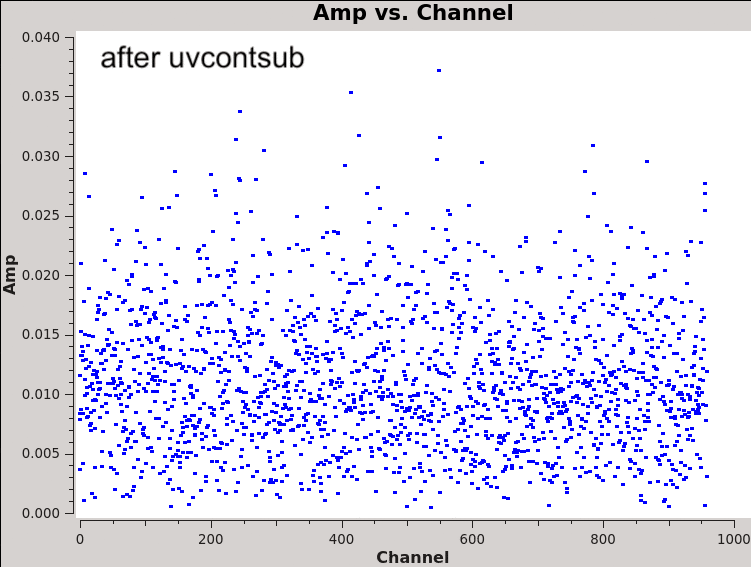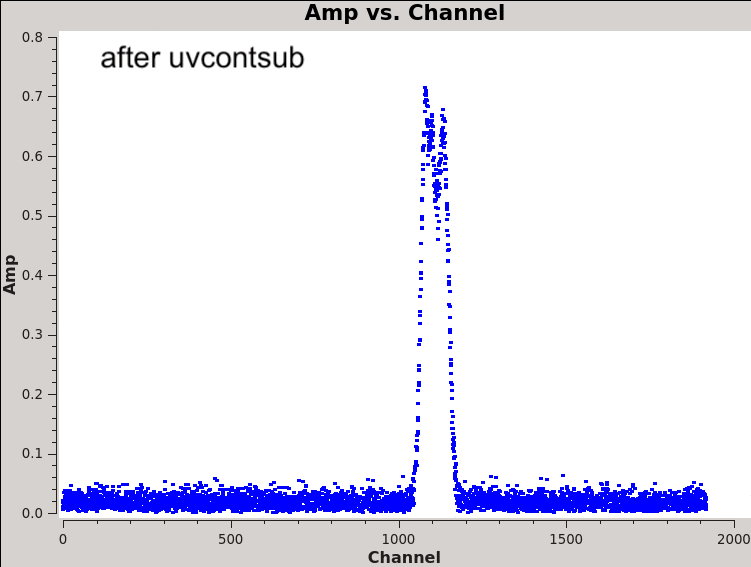Scripts for Step 4 - Prepare the lines:
step4_prepare_lines.py # main script
step4_detour.py # for phase alignment
dictionary_data.py # loads data_dict
step1_utils.py # loads multiple functions
analysisUtils (analysis_scripts/) # for channel strings
Continuum Subtraction#
We perform continuum subtraction in uv-space with CASA task uvcontsub.
Channels used to fit the continuum are the inverse of those used to flag the spectral lines in Pseudo-continuum Measurement Sets. We again use the DSHARP function get_flagchannels (reductions_utils.py) using the same velocity ranges selected in Step 1, and then “flip” them using the analysisUtils function invertChannelRanges:
flagchannels_string = get_flagchannels(ms_file = inputvis,
ms_dict = data_dict[EB],
velocity_range = data_dict[EB]['velocity_ranges'])
fitspw = au.invertChannelRanges(flagchannels_string, vis=inputvis)
velocity_ranges = np.array([np.array([ddisk.disk_dict['v_sys']-3., ddisk.disk_dict['v_sys']+3.]),
np.array([ddisk.disk_dict['v_sys']-4., ddisk.disk_dict['v_sys']+4.]),
np.array([ddisk.disk_dict['v_sys']-6., ddisk.disk_dict['v_sys']+6.]),
np.array([ddisk.disk_dict['v_sys']-10., ddisk.disk_dict['v_sys']+10.])])
Here are the resulting channels in each spectral window to be used by uvcontsub to fit the continuum, formatted as the necessary strings:
Flagchannels input string for SB_EB1: '1:517~589, 2:504~600, 3:961~1251, 4:556~1059'
fitspw: 1:0~516;590~959, 2:0~503;601~959, 3:0~960;1252~1919, 4:0~555;1060~1919
Flagchannels input string for SB_EB2: '1:517~589, 2:504~600, 3:962~1251, 4:554~1058'
fitspw: 1:0~516;590~959, 2:0~503;601~959, 3:0~961;1252~1919, 4:0~553;1059~1919
Flagchannels input string for LB_EB1: '1:516~589, 2:504~600, 3:960~1249, 4:553~1057'
fitspw: 1:0~515;590~959, 2:0~503;601~959, 3:0~959;1250~1919, 4:0~552;1058~1919
Flagchannels input string for LB_EB2: '1:517~589, 2:504~600, 3:960~1249, 4:553~1057'
fitspw: 1:0~516;590~959, 2:0~503;601~959, 3:0~959;1250~1919, 4:0~552;1058~1919
Flagchannels input string for LB_EB3: '1:517~589, 2:505~601, 3:960~1249, 4:553~1057'
fitspw: 1:0~516;590~959, 2:0~504;602~959, 3:0~959;1250~1919, 4:0~552;1058~1919
Flagchannels input string for LB_EB4: '1:516~589, 2:504~600, 3:960~1249, 4:553~1057'
fitspw: 1:0~515;590~959, 2:0~503;601~959, 3:0~959;1250~1919, 4:0~552;1058~1919
Flagchannels input string for LB_EB5: '1:516~588, 2:504~600, 3:960~1250, 4:553~1057'
fitspw: 1:0~515;589~959, 2:0~503;601~959, 3:0~959;1251~1919, 4:0~552;1058~1919
Flagchannels input string for LB_EB6: '1:517~589, 2:505~601, 3:960~1249, 4:553~1057'
fitspw: 1:0~516;590~959, 2:0~504;602~959, 3:0~959;1250~1919, 4:0~552;1058~1919
The call to uvcontsub will re-index our line spectral windows.
for EB in data_dict['EBs']: # this takes 1hr10min per LB EB
inputvis = data_dict['NRAO_path']+data_dict[EB]['_initlines_selfcal.ms']
outputvis = data_dict['NRAO_path']+data_dict[EB]['_initlines_selfcal.ms.contsub']
spw = '1, 2, 3, 4' # only line spws; they will be renumbered 0,1,2,3
combine = '' # break at scan, field, and spw
fitorder = 1 # order of polynomial fit; default is 0; DSHARP uses 1 so we copy them
solint = 'int' # Timescale for per-baseline fit. default (recommended): ‘int’, i.e. no time averaging, do a fit for each integration and let the noisy fits average out in the image.continuum
excludechans = False # the channels in fitspw will be used to fit the continuum
want_cont = False # we don't need another ms to hold the continuum estimate
os.system('rm -rf ' + outputvis)
uvcontsub(vis=inputvis, spw=spw, combine=combine, fitorder=fitorder,
solint=solint, excludechans=excludechans, want_cont=want_cont,
fitspw=fitspw)
listobs(vis=outputvis, listfile=outputvis+'.listobs.txt')
Here is the before-and-after, for SB EB 1, for spectral windows SO, C18O, 13CO, and 12CO (left to right):
Velocity re-gridding with cvel2?
We do not regrid the measurement sets onto a common velocity grid using the cvel2 task; we let tclean do this during imaging so as not to bin already-binned data.
However, we did regrid the measurement sets in an early version. Here is some information on what happens if you do that.
A listobs can nicely show that a measurement set has been successfully regridded. Below for example is the relevant section of a listobs for LB EB1 spectral window for SO, before and after regridding with the the
cvel2task:
Spectral Windows: (1 unique spectral windows and 1 unique polarization setups)
SpwID Name #Chans Frame Ch0(MHz) ChanWid(kHz) TotBW(kHz) CtrFreq(MHz) BBC Num Corrs
0 X2090867609#ALMA_RB_06#BB_1#SW-01#FULL_RES 960 TOPO 219985.475 -61.035 58593.8 219956.2084 1 XX YY
Notice “Frame” changes from TOPO to LSRK:
Spectral Windows: (1 unique spectral windows and 1 unique polarization setups)
SpwID Name #Chans Frame Ch0(MHz) ChanWid(kHz) TotBW(kHz) CtrFreq(MHz) BBC Num Corrs
0 X2090867609#ALMA_RB_06#BB_1#SW-01#FULL_RES 960 LSRK 219978.920 -61.033 58592.0 219949.6544 1 XX YY
We can also check by looking at the channel frequencies in each execution block and each spectral window. Below is a gif showing how they become aligned after regridding.
SO:
C18O:
13CO:
12CO:








